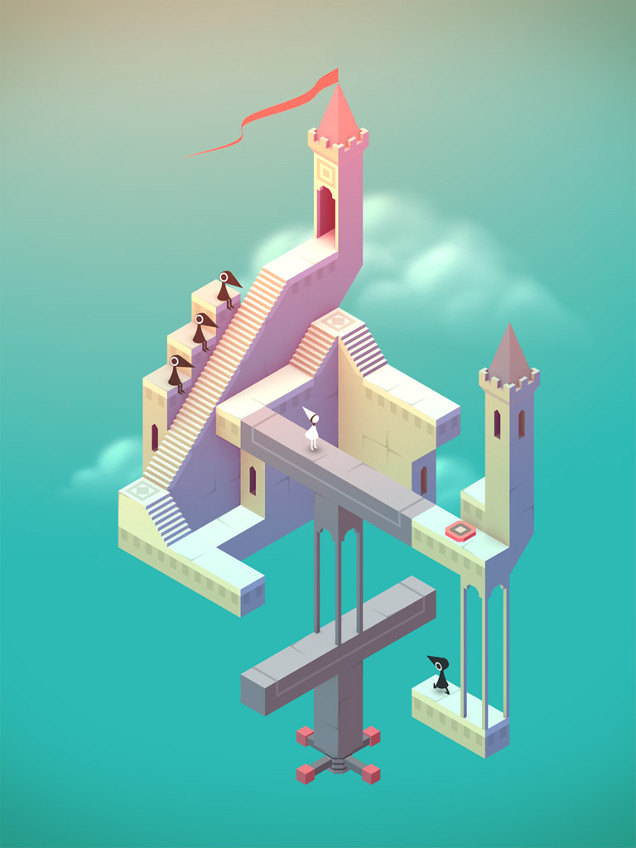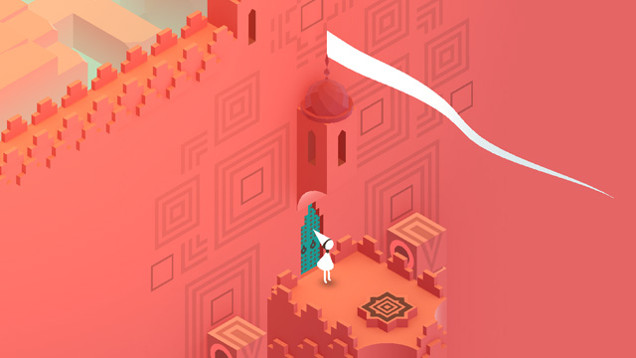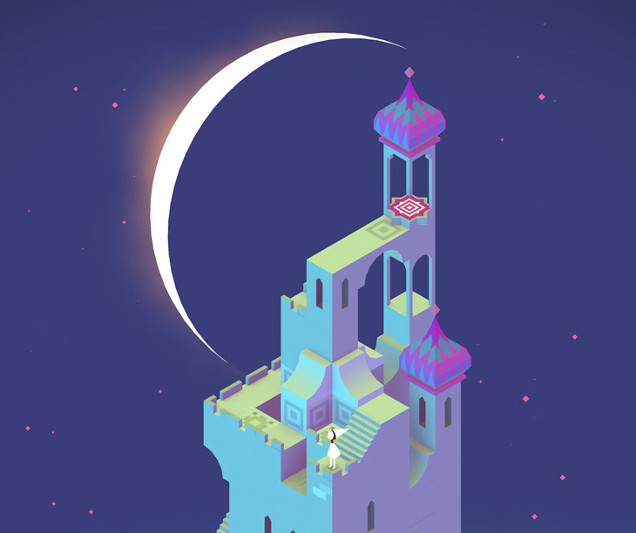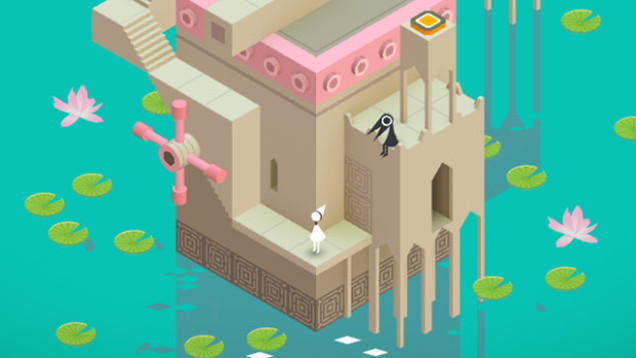Having sold over 500,000 copies for iOS platforms — a pretty tidy return given the £2.49 asking price — in less than two months of App Store visibility, it’s safe to say that ustwo’s Monument Valley is one of the mobile hits of 2014 so far. It’s just launched on Android too.
The M.C. Escher-inspired puzzler is beautiful not just to look at, but also to feel your way through; its tactile mechanics are intuitive and rewarding. Some have criticised its length — you’ll likely finish its 10 increasingly complex (though not necessarily complicated) stages in an hour’s sitting. But there really should be none of that horrible quality versus quantity debate when it comes to Monument Valley. With no in-app purchases, a very minimal user interface and wonderfully enveloping audio, it’s a very pure product, clutter-free and expertly streamlined.
Its architectural influence is perhaps a little obvious. ustwo is not the first studio to look to Escher for design inspiration, and certainly won’t be the last (The Bridge, for example, also borrows from the late Dutch artist’s singular style). But that doesn’t detract in the slightest from the game’s appeal. What might not be so obvious to players, though, is how ustwo’s team thought about the sequencing, and the story, of their creation’s stages.
“We thought about the game a lot like an album,” says Ken Wong, designer and artist for Monument Valley. “Take the story. There’s always a lot of discussion over how to do stories in games, and I think a lot of developers look to cinema for inspiration, with varying results.”
He continues: “When the time came for us to work on Monument Valley’s story, I looked at an album like [Pink Floyd’s] Dark Side Of The Moon. There is a story to that album, but it’s very tonal and lyrical. You might not have the firmest idea of what’s happening, but you get that feeling of emotional ups and downs, with these recurring characters. So I think we thought about the game like a series of tracks.”

Just like an album — or at least, one worth hearing more than the once (and Monument Valley certainly does reward repeat plays, not with material perks but simply through the gentle escapism its world provides) — these tracks can be approached in two ways. Firstly, as their maker intended: so, initially, all levels must be approached in order.
But once a stage is completed, it’s there to be replayed whenever the mood arises. Want to skip directly to the game’s penultimate chapter, its journey denouement, ‘The Descent’? Go for it. We all have our favourite songs, and ustwo recognise that players will have their favourite stages, those they want to return to time and again. And the team — eight people in total, who worked on the game for a 10-month period pre-launch, and continue to do so now — selected not just the best stages they’d created, but focused on how they worked as a whole.
“Just like picking tracks for an album, you want to select the best 10, maybe 12 tracks which are going to complement each other,” says Wong. “So, what you’re left over with is B-sides. Not to reveal too much, but I do think about the new chapters that we’re working on as B-sides.” Lead developer and level designer Peter Pashley chimes in: “B-sides that are good!”

Well, naturally. Anyone who has spent time with Monument Valley will have a respect for the care and attention its makers have evidently put into it, so to fob off paying customers — an active, fan-art-generating audience that grows with every download — with afterthought add-ons just isn’t going to cut it. In music terms, think about these B-sides more as something that a band like Mansun or Suede might have written in the 1990s, songs that stand up on their own terms and are the equals of many album inclusions, rather than the slew of second-rate remixes that used to pollute multiple-CD-release singles in the days before iTunes.
The music in Monument Valley isn’t anywhere near as busy as your garden-variety Pink Floyd prog-rocker. Rather, it’s a texturally deep backing that works in tandem with the emotional resonance of the visuals. Says Pashley: “We wanted music that served as an accompaniment, not a guide. With a 20-hour game, you can have recurring stings that get into your head, but as ours is so much shorter, doing that would have felt like we were forcing it on people, and it’d lose power that way. So, there’s a very deliberate minimalism at work.” The game’s soundtrack — “sound design” is credited to Stafford Bawler and Dev Morgan, using Tazman-Audio’s Fabric toolset — will be made available soon, according to the Monument Valley development blog.
Equally minimal is the game’s story. There are markings on some stages, clues that lead towards the true identity of the game’s silent princess, Ida, and how she’s related to the crows populating these grand designs. Reach the end and there’s certainly narrative closure, but ustwo were keen to not make their tale as matter-of-fact as it could have been.
“It’s something that people can work out for themselves,” says Wong. “You don’t need to hit people over the head with that stuff. If they figure it out for themselves, they will connect to it on a greater emotional level.” Pashley continues: “We have this emotional setting, which already involves the imagination. We wanted to bring in that feeling of reading a book, where your imagination is such a strong force. You don’t need that exact, explicit knowledge of what went on in this world for the emotion of it to be felt.”
The fact that ustwo’s approach to development goes against the grain of so many microtransaction-centric mobile games and yet has seen commercial success, is cause for celebration — and will hopefully open the door to more complete-package, paid-for titles that don’t ask for anything more than a one-off purchase. In Monument Valley’s wake have come the visually stimulating, sonically pulverising puzzler Kiwanuka and the Rayman-recalling side-scrolling platformer Leo’s Fortune, both gorgeous games which prioritise experience over exploitation.
“I think a lot of people were thinking that the industry had given up on making interesting or meaningful games for mobile,” says Wong. “Our strategy was not to put money first, but to make the best game possible. I think people are surprised that still works, and that’s really wonderful.

“A lot of games are built to fill our time — they fill the time we have when we’re bored, and it doesn’t matter if they’re crap. They’re like junk food — you’re hungry, so you fill that boredom. It’s interesting to see people who are used to that value paradigm, where they will pay money for a game just so that it blocks out as many hours as possible. With our game, we offer no watering down. It’s just good stuff.”
Good stuff that’s now sold more than half a million. Transfer those sales to British music certifications, and you’ve gone almost double platinum, in just a few weeks. It takes mettle to come out with a game like Monument Valley; it was never going to be a sure thing in a market dominated by F2P. But then, audentes fortuna iuvat, right?


Comments
One response to “The Making Of Monument Valley”
Beautiful little game that works great on the ipad. Reminds me of that psp game Echochrome.